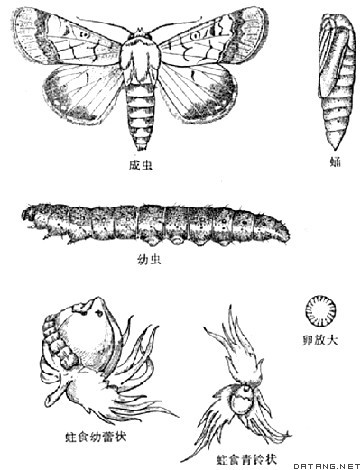1) second generation cotton bollworm(Helicoverpa armigera)


二代棉铃虫
1.
By the methods of geostatistics,this paper analyzed the temporal structural characters and autocorrelations of the population dynamics of second generation cotton bollworm(Helicoverpa armigera)in Binzou City of Shandong Province in 1965—2004.
运用地统计学方法,分析了山东省滨州地区二代棉铃虫在1965-2004年间种群动态的时间序列结构特征和自相关性,根据决定系数R2和Akaike's Information Criteria(AIC)判别参数,筛选出最优拟合模型。
2) the second generation of Helicoverpa armigera Hübner


第二代棉铃虫
1.
The Projection Pursuit Autoregression (PPAR) technology and grey system theory and method more compared by the analysing catastrophe prediction of the second generation of Helicoverpa armigera Hübner.
应用投影寻踪自回归方法 ,对第二代棉铃虫灾变性发生进行预测 ,其预测结果与用灰色系统理论方法预测结果比较 ,提高了预测精度 16。
3) Fourth generation cotton boll worm


4代棉铃虫
4) 4th generation of Heliothis armigera Hubner


第4代棉铃虫
5) the fifth generation cotton bollworm


第五代棉铃虫
6) the third generation pink bollworm (Pectinophora gossypiella)


三代棉红铃虫
补充资料:棉铃虫
| 棉铃虫 Heliothis armigera 主要为害棉花蕾、铃的世界性害虫。鳞翅目夜蛾科。俗称青虫、钻桃虫。在中国遍布各棉区,以黄河流域棉区为害较重,长江流域棉区有些年份也较烈。寄主还有玉米、小麦、大麦、高粱、大豆、花生、豌豆、蚕豆、苜蓿、苕子、番茄、辣椒、芝麻、向日葵、南瓜、苘麻、红麻、亚麻、烟草等作物及多种野生植物。在黄河流域棉区1年发生 4 代 ,以第二、三代为害重;长江流域棉区4~5代,以第三、四代为害严重;辽河流域及新疆棉区3代 ,以第二代为害严重 。生长最适温度为25~28℃,相对湿度 70% 左右。成虫借气流迁移扩散。3龄后幼虫食量增大且有自相残杀性 。4、5月间遇低温、第一、二代的发生量减少;蛹期土壤含水量长期处于饱和状态,导致蛹大量死亡;第四代发生期由于天敌的作用,一般可不进行防治。凡长势好、着蕾早而多的棉田着卵量大;郁闭而湿度大的棉田则发生重。防治方法:结合冬耕冬灌破坏越冬虫蛹;选育和种植抗虫品种或种植短季棉品种;保护和利用天敌;适时喷布久效磷、甲基对硫磷、杀灭菊酯等农药防治。
|
说明:补充资料仅用于学习参考,请勿用于其它任何用途。
参考词条
